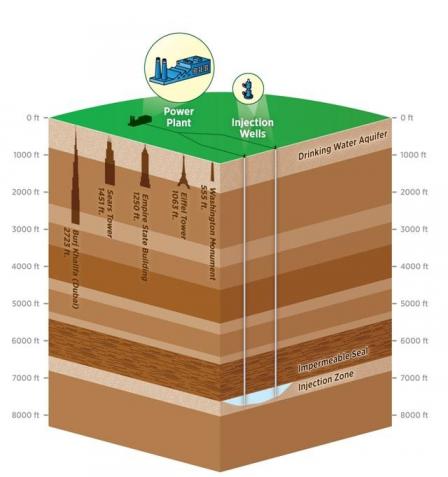Carbon Capture Utilization and Storage (CCUS) is a process and also a technology that helps reduce carbon dioxide (CO2) emissions from the atmosphere while continuing to meet present and future energy demands.
It involves the following steps:
- Capturing CO2 from an industrial source such as coal and gas power plants or cement and steel plants to name a few
- Transporting the compressed CO2 to a dedicated geological storage site or for utilization as a tertiary injectant in enhanced oil recovery (EOR) or to make other products.
- Leaving the CO2 permanently in EOR or injecting compressed CO2 into a deep subsurface rock formation for permanent geological sequestration
The U.S. Department of Energy (DOE) estimates that the U.S. could sequester roughly 1-4 trillion metric tons of CO2. Currently, annual total U.S. emissions of CO2 are approximately 5.5 billion metric tons; therefore, there is sufficient storage capacity for many decades to come.

How is CO2 Captured?
There are several ways that CO2 can be captured. One of those methods is where CO2 is captured from a combustion plant, which is a place where fuel is burned to create heat. These are your mills, power plants, steel plants, etc. where the technology is retrofitted onto existing equipment in the plant. This helps save costs building a new plant and prevents taking down a source of energy or a piece of the industrial process.
Oxy-fuel combustion is another technology that can capture CO2. In this process, you inject pure oxygen (rather than air) into the available chamber where fossil fuel is being burned. The oxy-fuel process produces an exhaust stream of virtually pure CO2, making separation from other combustion by-products unnecessary.
Capturing CO2 can occur before, during, or after fuel is combusted. With pre-combustion technologies, CO2 is removed from traditional fuel prior to combustion. With post-combustion technology, a chemical reaction is used to capture CO2 from flue gas (think of the chimney on a fireplace) after the fuel is burned.
Transporting Captured CO2
In some cases, once CO2 is captured it has to be transported to where it can be sequestered (or stored) if it is not being used for consumer applications (e.g. wine and beer making, research and pharmaceuticals, and for metals and manufacturing). CO2 is non-flammable, colorless, and odorless and can be transported as a solid, liquid, or gas. For the CCUS process in the U.S., CO2 is compressed and primarily transported via the existing 5,100 miles of CO2 pipelines, but can also be delivered by train, truck, ship, or barge.
Injecting CO2 for Sequestration

There are two primary ways CO2 is geologically sequestered. One way is through the EOR process by injecting CO2 into the ground as a way of producing stranded oil. EOR, also known as tertiary recovery, has the unique advantage of utilizing CO2 in the recovery process. Throughout the injection of CO2 into an old oil field, recovery and processing of the oil and gas mixture, and subsequent re-injection of separated and recycled CO2, virtually all of the CO2 used in EOR becomes sequestered deep below the Earth’s surface.
Separately, CO2 can be injected into a deep subsurface rock formation for long-term geological sequestration after the viability of the site has been verified.
CCUS, Emissions and Greenhouse Gas Reduction
The Biden-Harris Administration is supportive of CCUS as a way of meeting its climate goals. The Administration has called for $75 million in funding to engineer carbon capture projects. According to the Administration, “This funding will support customized engineering designs to install carbon capture and storage technology for power and industrial plants. Retrofitting with carbon capture technology could employ a similar workforce that exists today in energy communities and position American industry to compete in a global economy”. The Administration released a report stating that If the United States wants to hit its climate targets, CCUS deployment “should increase tenfold” over the next decade, citing research.
The biggest benefit of capturing and storing CO2 is its ability to help other industrial processes get closer to achieving net-zero by producing lower carbon intensity fuels, chemicals, materials, and products (e.g., concrete) that the market demands. Every day we can get closer to net zero, is one day closer to clearing the air.

